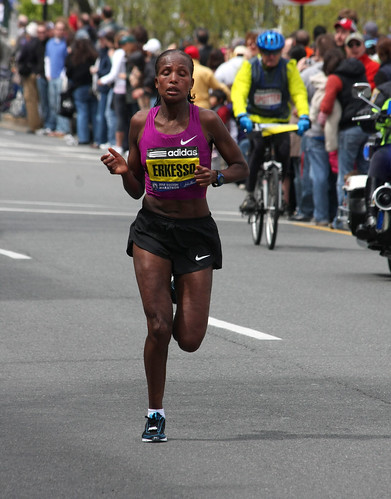I metaphorically unfolded my copy of the Los Angeles Times this morning and was immediately struck by this image:

(Photo by Irfan Khan for the Los Angeles Times)
The picture is from the World Famous Mud Run, an annual event at Camp Pendleton where civilians are invited to run on a Marine obstacle course. Judging from the people I saw in costumes in the photo set accompanying the article, it looks a lot like San Francisco’s (in)famous Bay to Breakers; a mix of serious competitors and people having fun, folks dressing up in silly costumes and people in running gear, cheering bystanders, and, in this case, a whole lot of mud.
Here’s a picture from the Bay to Breakers—evidently tutus are a bit of a theme:

(Photo by Flickr user M. Skaffari, Creative Commons license)
There are all kinds of fascinating things going on in these images. The tutu is kind of a troped image associated with performances of femininity and ‘grace.’ We don’t expect to see a staple of the ballet stage covered in mud and froth, or to see a woman in running shoes completing a marathon with a frilly tutu bouncing above her knees. These women have at least moderately athletic bodies, especially the woman on the far right in the Mud Run image, who appears to have pretty toned legs. I kind of love that these women are reversing the Serious Female Athlete image you usually see in competition; here’s Teyba Erkesso competing in the Boston Marathon for contrast:

(Photo by Flickr user hbp_pix, Creative Commons license)
Now, obviously, there are really good reasons to wear athletic clothes when you are competing in marathons and other athletic events. There’s a reason athletes wear that stuff, and it’s not just because all the other athletes are doing it.
That doesn’t mean I can’t appreciate, on a certain level, the sight of ladies having fun in the mud in tutus. It feels tongue in cheek to me in a way that I find rather delicious; I’m really interested in costuming and uniforms right now, in the sense of what clothing is appropriate to different situations and how people use clothing for performance, and so I’m intrigued by this image that clashes stereotypical femininity with athleticism. Especially since gender performance is often criticised for its impracticality; many women, for example, are uncomfortable in heels, or find ‘appropriate business attire’ restrictive and unpleasant to wear. Here, women are choosing to wear impractical garments that are not appropriate for the setting, subverting the norm even as they have bodies that are ‘allowed’ to do this; they are slim and athletic. If there was a team of fat runners wearing tutus in this competition, the Times chose not to include them in this photo set. Layers upon layers are going on here.
We see this happening with Halloween, too, where people feel a license to costume as something other than themselves, but there are also Rules about who is allowed to wear what, and in what setting. The same rules are very much in play with these images. Subvert the dominant narrative, but not too much, ladies! How subversive is it if there are unspoken limits in play, certain types of bodies that are allowed to do this while others are not?
What I found especially interesting about this image, though, is what we don’t see.
Who is that figure just to the right who is partially cut off? It almost looks like a man wearing a tutu. The person is clearly with the women, because ou arms are raised with the last runner we can fully see. Yet, either the photographer composed the photo to cut that person out, or the photo was cropped later by the photographer or an editor. Believe me, that decision was not unintentional. The Times undoubtedly had multiple photographers stationed along the route with high speed film, with hundreds of pictures to choose from, including probably multiple pictures of this group of runners. It’s not like they were struggling to find pictures to include in this article and said ‘well, someone’s kind of cut off in this picture, but I guess we can use it.’ There’s a reason that person is partially cut out of this image, why the photographer didn’t go just a tad wider to show the whole row of runners together.
Why?
Is it because slim women in tutus running is ‘fun’ and men in tutus is a scary challenge to gender boundaries? Because that runner isn’t obeying the Rules?